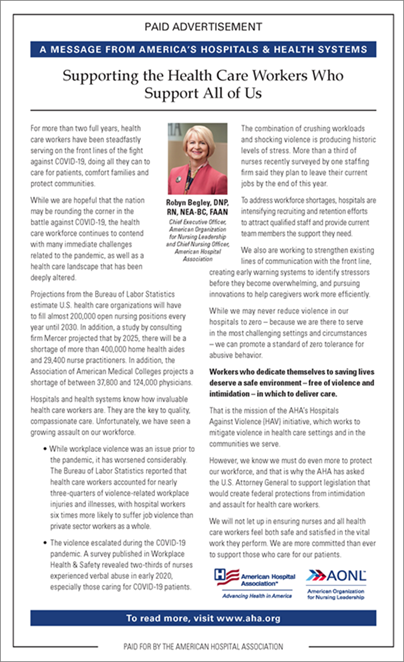

Advertorial: Supporting the Health Care Workers Who Support All of Us - April 25, 2022
by Robyn Begley, DNP, RN, NEA-BC, FAAN
A Message from America's Hospitals & Health Systems
As Seen in The Wall Street Journal
For more than two full years, health care workers have been steadfastly serving on the front lines of the fight against COVID-19, doing all they can to care for patients, comfort families and protect communities.
While we are hopeful that the nation may be rounding the corner in the battle against COVID-19, the health care workforce continues to contend with many immediate challenges related to the pandemic, as well as a health care landscape that has been deeply altered.
Projections from the Bureau of Labor Statistics estimate U.S. health care organizations will have to fill almost 200,000 open nursing positions every year until 2030. In addition, a study by consulting firm Mercer projected that by 2025, there will be a shortage of more than 400,000 home health aides and 29,400 nurse practitioners. In addition, the Association of American Medical Colleges projects a shortage of between 37,800 and 124,000 physicians.
Hospitals and health systems know how invaluable health care workers are. They are the key to quality, compassionate care. Unfortunately, we have seen a growing assault on our workforce.
- While workplace violence was an issue prior to the pandemic, it has worsened considerably. The Bureau of Labor Statistics reported that health care workers accounted for nearly three-quarters of violence-related workplace injuries and illnesses, with hospital workers six times more likely to suffer job violence than private sector workers as a whole.
- The violence escalated during the COVID-19 pandemic. A survey published in Workplace Health & Safety revealed two-thirds of nurses experienced verbal abuse in early 2020, especially those caring for COVID-19 patients.
The combination of crushing workloads and shocking violence is producing historic levels of stress. More than a third of nurses recently surveyed by one staffing firm said they plan to leave their current jobs by the end of this year.
To address workforce shortages, hospitals are intensifying recruiting and retention efforts to attract qualified staff and provide current team members the support they need.
We also are working to strengthen existing lines of communication with the front line, creating early warning systems to identify stressors before they become overwhelming, and pursuing innovations to help caregivers work more efficiently.
While we may never reduce violence in our hospitals to zero – because we are there to serve in the most challenging settings and circumstances – we can promote a standard of zero tolerance for abusive behavior.
Workers who dedicate themselves to saving lives deserve a safe environment – free of violence and intimidation – in which to deliver care.
That is the mission of the AHA’s Hospitals Against Violence (HAV) initiative, which works to mitigate violence in health care settings and in the communities we serve.
However, we know we must do even more to protect our workforce, and that is why the AHA has asked the U.S. Attorney General to support legislation that would create federal protections from intimidation and assault for health care workers.
We will not let up in ensuring nurses and all health care workers feel both safe and satisfied in the vital work they perform. We are more committed than ever to support those who care for our patients.


